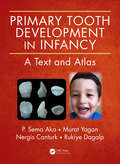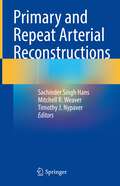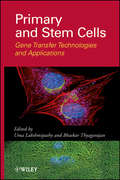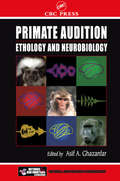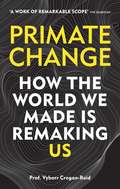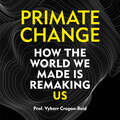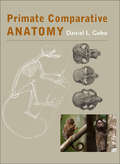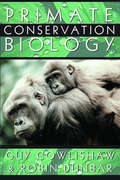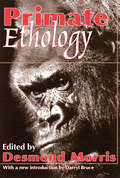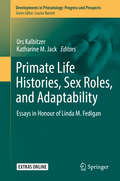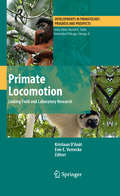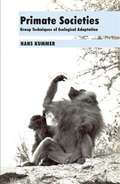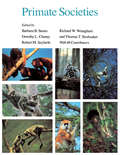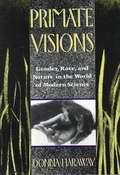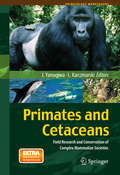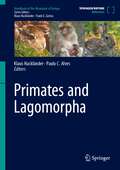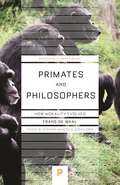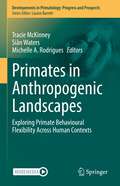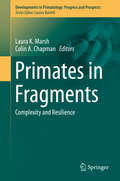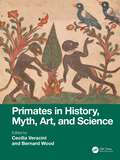- Table View
- List View
Primary Tooth Development in Infancy: A Text and Atlas
by P. Sema Aka Murat Yagan Nergis Canturk Rukiye DagalpThis color atlas and textbook describes the initial phase of human dentition. It includes more than 1,500 photographs of fetal and infant teeth up to the age of one year. Photographs with concise explanatory text depict steps of these developmental phases. The teeth are photographed from six different aspects: buccal, lingual, mesial, distal, incisal, and from the root direction. A supplementary software program for age estimation from dental measurements can also be used in conjunction with the material in this text.
Primary and Repeat Arterial Reconstructions
by Sachinder Singh Hans Mitchell R. Weaver Timothy J. NypaverThis text provides comprehensive atlas of open arterial reconstructions - primary and reoperations. This book describes in detail the 1) indications of the operation, 2) surgical anatomy 3) operative steps in a sequential order with easy to understand illustrations, 4) recognizing a potential complication 5) and if a complication occurs, the steps involved in managing the complication.
Primary and Stem Cells
by Uma Lakshmipathy Bhaskar ThyagarajanThis book describes basic cell engineering methods, emphasizing stem cell applications, and use of the genetically modified stem cells in cell therapy and drug discovery. Together, the chapters introduce and offer insights on new techniques for engineering of stem cells and the delivery of transgenes into stem cells via various viral and non-viral systems. The book offers a guide to the types of manipulations currently available to create genetically engineered stem cells that suit any investigator's purpose, whether it's basic science investigation, creation of disease models and screens, or cells for therapeutic applications.
Primate Audition: Ethology and Neurobiology (Frontiers in Neuroscience)
by Asif A. GhazanfarBringing together the knowledge of world experts on different aspects of primate auditory function, this book bridges the epistemological gap between primate ethologists and auditory neurobiologists. Leading ethologists, comparative psychologists, and neuroscientists who have developed new experimental approaches apply their methods to a variety of issues dealing with primate vocal behavior and the neurobiology of the primate auditory system. The synthesis of ethological and neurobiological approaches to primate vocal behavior presented in this book will yield a rich understanding of the acoustic and neural bases of primate audition and shed light on the evolutionary precursors to speech.
Primate Change: How the world we made is remaking us
by Vybarr Cregan-Reid'A work of remarkable scope' - GuardianFT Best science books of 2018Primate Change has been adapted into a radio series for the BBC WORLD SERVICE.*This is the road from climate change to primate change.PRIMATE CHANGE is a wide-ranging, polemical look at how and why the human body has changed since humankind first got up on two feet. Spanning the entirety of human history - from primate to transhuman - Vybarr Cregan-Reid's book investigates where we came from, who we are today and how modern technology will change us beyond recognition.In the last two hundred years, humans have made such a tremendous impact on the world that our geological epoch is about to be declared the 'Anthropocene', or the Age of Man. But while we have been busy changing the shape of the world we inhabit, the ways of living that we have been building have, as if under the cover of darkness, been transforming our bodies and altering the expression of our DNA, too.Primate Change beautifully unscrambles the complex architecture of our modern human bodies, built over millions of years and only starting to give up on us now.'Our bodies are in a shock. Modern living is as bracing to the human body as jumping through a hole in the ice. Our bodies do not know what century they were born into and they are defending and deforming themselves in response.'
Primate Change: How the world we made is remaking us
by Vybarr Cregan-ReidIF YOU THINK YOU ARE YOU, THINK AGAIN.PRIMATE CHANGE is a wide-ranging, polemical look at how and why the human body has changed since humankind first got up on two feet. Spanning the entirety of human history - from primate to transhuman - Vybarr Cregan-Reid's book investigates where we came from, who we are today and how modern technology will change us beyond recognition.In the last two hundred years, humans have made such a tremendous impact on the world that our geological epoch is about to be declared the 'Anthropocene', or the Age of Man. But while we have been busy changing the shape of the world we inhabit, the ways of living that we have been building have, as if under the cover of darkness, been transforming our bodies and altering the expression of our DNA, too.PRIMATE CHANGE beautifully unscrambles the complex architecture of our modern human bodies, built over millions of years and only starting to give up on us now.'Our bodies are in a shock. Modern living is as bracing to the human body as jumping through a hole in the ice. Our bodies do not know what century they were born into and they are defending and deforming themselves in response'
Primate Change: How the world we made is remaking us
by Vybarr Cregan-ReidIF YOU THINK YOU ARE YOU, THINK AGAIN.PRIMATE CHANGE is a wide-ranging, polemical look at how and why the human body has changed since humankind first got up on two feet. Spanning the entirety of human history - from primate to transhuman - Vybarr Cregan-Reid's book investigates where we came from, who we are today and how modern technology will change us beyond recognition.In the last two hundred years, humans have made such a tremendous impact on the world that our geological epoch is about to be declared the 'Anthropocene', or the Age of Man. But while we have been busy changing the shape of the world we inhabit, the ways of living that we have been building have, as if under the cover of darkness, been transforming our bodies and altering the expression of our DNA, too.PRIMATE CHANGE beautifully unscrambles the complex architecture of our modern human bodies, built over millions of years and only starting to give up on us now.'Our bodies are in a shock. Modern living is as bracing to the human body as jumping through a hole in the ice. Our bodies do not know what century they were born into and they are defending and deforming themselves in response'(p) 2018 Octopus Publishing Group
Primate Communication
by Anne M. Burrows Katja Liebal Bridget M. Waller Anne M. Burrows Katie E. Slocombe Katja Liebal Bridget M. WallerPrimates communicate with each other using a wide range of signals: olfactory signals to mark territories, screams to recruit help while fighting, gestures to request food and facial expressions to initiate play. Primate Communication brings together research on all forms of interchange and discusses what we know about primate communication via vocal, gestural, facial, olfactory and integrated multimodal signals in relation to a number of central topics. It explores the morphological, neural and cognitive foundations of primate communication through discussion of cutting-edge research. By considering signals from multiple modalities and taking a unified multimodal approach, the authors offer a uniquely holistic overview of primate communication, discussing what we know, what we don't know and what we may currently misunderstand about communication across these different forms. It is essential reading for researchers interested in primate behaviour, communication and cognition, as well as students of primatology, psychology, anthropology and cognitive sciences.
Primate Comparative Anatomy
by Daniel L. GeboA comprehensive, illustrated textbook that reveals the structural and functional anatomy of primates.Winner of the CHOICE Outstanding Academic Title of the Choice ACRLWhy do orangutan arms closely resemble human arms? What is the advantage to primates of having long limbs? Why do primates have forward-facing eyes? Answers to questions such as these are usually revealed by comparative studies of primate anatomy.In this heavily illustrated, up-to-date textbook, primate anatomist Daniel L. Gebo provides straightforward explanations of primate anatomy that move logically through the body plan and across species. Including only what is essential in relation to soft tissues, the book relies primarily on bony structures to explain the functions and diversity of anatomy among living primates. Ideal for college and graduate courses, Gebo's book will also appeal to researchers in the fields of mammalogy, primatology, anthropology, and paleontology.Included in this book are discussions of:• Phylogeny• Adaptation• Body size• The wet- and dry-nosed primates• Bone biology• Musculoskeletal mechanics• Strepsirhine and haplorhine heads• Primate teeth and diets• Necks, backs, and tails• The pelvis and reproduction• Locomotion• Forelimbs and hindlimbs• Hands and feet• Grasping toes
Primate Conservation Biology
by Robin Dunbar Guy CowlishawFrom the snub-nosed monkeys of China to the mountain gorillas of central Africa, our closest nonhuman relatives are in critical danger worldwide. A recent report, for example, warns that nearly 20 percent of the world's primates may go extinct within the next ten or twenty years. In this book Guy Cowlishaw and Robin Dunbar integrate cutting-edge theoretical advances with practical management priorities to give scientists and policymakers the tools they need to help keep these species from disappearing forever.Primate Conservation Biology begins with detailed overviews of the diversity, life history, ecology, and behavior of primates and the ways these factors influence primate abundance and distribution. Cowlishaw and Dunbar then discuss the factors that put primates at the greatest risk of extinction, especially habitat disturbance and hunting. The remaining chapters present a comprehensive review of conservation strategies and management practices, highlighting the key issues that must be addressed to protect primates for the future.
Primate Ethology
by Pendleton HerringThis is a groundbreaking workwhich brought together studiesof monkeys and apes from boththe laboratory and the field. Manybroad aspects of primate life,including facial expressions,sexual signals, grooming, play,social organization and parental care, are covered bythe contributors and provided a whole new approach toprimate behavior.
Primate Evolution and Human Origins
by Russell L. CiochonPrimate Evolution and Human Origins compiles, for the first time, the major ideas and publications that have shaped our current view of the evolutionary biology of the primates and the origin of the human line. Designed for freshmen-to-graduate students in anthropology, paleontology, and biology, the book is a unique collection of classic papers, culled from the past 20 years of research. It is also an important reference for academicians and researchers, as it covers the entire scope of primate and human evolution (with an emphasis on the fossil record). A comprehensive bibliography cites over 2000 significant articles not found in the main text.
Primate Life Histories, Sex Roles, and Adaptability: Essays in Honour of Linda M. Fedigan (Developments in Primatology: Progress and Prospects)
by Urs Kalbitzer Katharine M. JackProfessor Linda M. Fedigan, Member of the Order of Canada and a Fellow of the Royal Society of Canada, has made major contributions to our understanding of the behavioural ecology of primates. Furthermore, Linda Fedigan pioneered and continues to advance scholarship on the role of women in science, as well as actively promoting the inclusion of women in the academy. A symposium in honour of her career was held in Banff (Alberta, Canada) in December 2016, during which former and current students and collaborators, as well as scientists with similar research interests, presented and discussed their work and their connections to Linda Fedigan. These presentations and discussions are here presented as chapters in this festschrift. The original works presented in this book are organized around four major research areas that have been greatly advanced and influenced by Linda Fedigan:Primate life historiesSex roles, gender, and sciencePrimate-environment interactionsPrimate adaptation to changing environments
Primate Locomotion
by Kristiaan D'Août Evie E. VereeckePrimate locomotion has typically been studied from two points of view. Laboratory-based researchers have focused on aspects like biomechanics and energetics, whereas field-based researchers have focused on (locomotor) behaviour and ecology. Unfortunately, to date, there is relatively little scientific exchange between both groups. With a book, which will be the result of a symposium on the 2008 Meeting of the International Primatological Society in Edinburgh, we would like to bring together laboratory and field-based primate locomotion studies. We are convinced this will be beneficial for both research lines. For example, biomechanists might wonder how frequently the locomotor style they study in the lab actually occurs in nature, and field workers might use calculated costs of locomotion to understand why certain locomotor behaviours are favoured under specific conditions. Thus, on the one hand, an established link between both groups may help interpret the results by using each other's findings. On the other hand, recent technological advances (e.g. portable high-speed cameras) make it possible to bridge the gap between lab-based and field-based research by actually collecting biomechanical data in situ. Again, communication between both groups is necessary to identify the specific needs and start up achievable and successful research projects in the field. In order to generate a wide interest, we have invited biomechanists, ecologists, and field-based researchers who combine both disciplines, and we hope their combined contributions will facilitate lasting cooperation between the mentioned disciplines and stimulate innovative research in Primatology. We are convinced that the most appropriate format to publish the different symposium contributions is a conference volume within an existing book series. Firstly, the chapters will not only contain new data but will also review existing data and elaborate on potential future work - more so than can be done in a journal article. Secondly, the combination of chapters will form an entity that is more valuable than the sum of the separate chapters and therefore they need to be presented together. Lastly, this volume will benefit from the typically long "shelf life" of a book in a renowned series, allowing it to be used as reference book for both researchers and students.
Primate Psychology
by Dario MaestripieriIn more ways than we may sometimes care to acknowledge, the human being is just another primate--it is certainly only very rarely that researchers into cognition, emotion, personality, and behavior in our species and in other primates come together to compare notes and share insights. This book, one of the few comprehensive attempts at integrating behavioral research into human and nonhuman primates, does precisely that--and in doing so, offers a clear, in-depth look at the mutually enlightening work being done in psychology and primatology. Relying on theories of behavior derived from psychology rather than ecology or biological anthropology, the authors, internationally known experts in primatology and psychology, focus primarily on social processes in areas including aggression, conflict resolution, sexuality, attachment, parenting, social development and affiliation, cognitive development, social cognition, personality, emotions, vocal and nonvocal communication, cognitive neuroscience, and psychopathology. They show nonhuman primates to be far more complex, cognitively and emotionally, than was once supposed, with provocative implications for our understanding of supposedly unique human characteristics. Arguing that both human and nonhuman primates are distinctive for their wide range of context-sensitive behaviors, their work makes a powerful case for the future integration of human and primate behavioral research.
Primate Societies: Group Techniques of Ecological Adaptation (Worlds Of Man Ser.)
by Hans KummerIn this book, Hans Kummer, one of the world's leading primate ethologists, examines the patterns of social interaction among primates. He examines this social behavior from the fundamentally biological viewpoint of evolutionary adaptation as part of the survival mechanisms for the species. Recognizing that all activity is constituted in part of genetic programming and in part of adaptive behavior, he explores the borderline area between the genetic and the "cultural." By use of astute observation and clever experimentation he shows that many aspects of social behavior are inherited, and differentially inherited among various primate groups. These data also show, however, that the individuals and troops learn much in primate social life and that these forms are responsive to particular ecological situations. Drawing heavily on knowledge gleaned from his own well-known studies of the Hamadryas baboon, Dr. Kummer introduces the reader to the daily life of a particular primate society. From this sample case, he proceeds to a more general characterization of primate societies, using as examples the great apes and monkeys of Africa, Asia, and South America and particularly the widely studied terrestrial monkey species. The particularities of primate communication, social structure, and economy are described and special attention is devoted to the primate counterparts of kinship and age groups-behavioral differences based on age and sex, and mating and grouping systems. This is followed by a chapter dealing with the ecological functions of the major parameters of primate social life, such as group size and the coordination of activities within it-dominance, leadership systems, and spatial arrangements. The second part of the book is concerned with the origins of behavioral traits of primates, discussed from phylogenetic, ecological, and cultural points of view, again using data-based examples. Dr. Kummer explains why some traits have not evolved that would have been ada
Primate Societies: With 46 Contributors
by Barbara B. Smuts, Dorothy L. Cheney, Robert M. Seyfarth, Richard W. Wrangham and Thomas T. StruhsakerPrimate Societies is a synthesis of the most current information on primate socioecology and its theoretical and empirical significance, spanning the disciplines of behavioral biology, ecology, anthropology, and psychology. It is a very rich source of ideas about other taxa. "A superb synthesis of knowledge about the social lives of non-human primates."—Alan Dixson, Nature
Primate Tourism
by Anne E. Russon Janette WallisPrimate tourism is a growing phenomenon, with increasing pressure coming from several directions: the private sector, governments, and conservation agencies. At the same time, some primate sites are working to exclude or severely restrict tourism because of problems that have developed as a result. Indeed, tourism has proven costly to primates due to factors such as disease, stress, social disruption, vulnerability to poachers, and interference with rehabilitation and reintroduction. Bringing together interdisciplinary expertise in wildlife/nature tourism and primatology, experts present and discuss their accumulated experience from individual primate sites open to tourists, formal studies of primate-focused tourism, and trends in nature and wildlife tourism. Chapters offer species- and site-specific assessments, weighing conservation benefits against costs, and suggesting strategies for the development of informed guidelines for ongoing and future primate tourism ventures. Primate Tourism has been written for primatologists, conservationists and other scientists. It is also relevant to tourists and tourism professionals.
Primate Visions: Gender, Race, and Nature in the World of Modern Science
by Donna HarawayHaraway's discussions of how scientists have perceived the sexual nature of female primates opens a new chapter in feminist theory, raising unsettling questions about models of the family and of heterosexuality in primate research.
Primates and Cetaceans
by Juichi Yamagiwa Leszek KarczmarskiIn this book, the editors present a view of the socioecology of primates and cetaceans in a comparative perspective to elucidate the social evolution of highly intellectual mammals in terrestrial and aquatic environments. Despite obvious differences in morphology and eco-physiology, there are many cases of comparable, sometimes strikingly similar patterns of sociobehavioral complexity. A number of long-term field studies have accumulated a substantial amount of data on the life history of various taxa, foraging ecology, social and sexual relationships, demography, and various patterns of behavior: from dynamic fission-fusion to long-term stable societies; from male-bonded to bisexually bonded to matrilineal groups. Primatologists and cetologists have come together to provide four evolutionary themes: (1) social complexity and behavioral plasticity, (2) life history strategies and social evolution, (3) the interface between behavior, demography, and conservation, and (4) selected topics in comparative behavior. These comparisons of taxa that are evolutionarily distant but live in comparable complex sociocognitive environments boost our appreciation of their sophisticated mammalian societies and can advance our understanding of the ecological factors that have shaped their social evolution. This knowledge also facilitates a better understanding of the day-to-day challenges these animals face in the human-dominated world and may improve the capacity and effectiveness of our conservation efforts.
Primates and Lagomorpha (Handbook of the Mammals of Europe)
by Paulo C. Alves Klaus HackländerThis volume provides comprehensive overviews of the primate’s and each lagomorph species’ biology including palaeontology, physiology, genetics, reproduction and development, ecology, habitat, diet, mortality and age determination. Their economic significance and management, as well as future challenges for research and management are also addressed. Each chapter includes a distribution map, a photograph of the animal and key literature. This authoritative volume of the Handbook of the Mammals of Europe is a timely and detailed compilation of all European primates and lagomorphs and will appeal to academics and students in mammal research, as well as to professionals dealing with mammal management, including control, use and conservation.
Primates and Philosophers: How Morality Evolved (Princeton Science Library #43)
by Frans de WaalCan virtuous behavior be explained by nature, and not by human rational choice? "It's the animal in us," we often hear when we've been bad. But why not when we're good? Primates and Philosophers tackles this question by exploring the biological foundations of one of humanity's most valued traits: morality. In this provocative book, renowned primatologist Frans de Waal argues that modern-day evolutionary biology takes far too dim a view of the natural world, emphasizing our "selfish" genes and reinforcing our habit of labeling ethical behavior as humane and the less civilized as animalistic. Seeking the origin of human morality not in evolution but in human culture, science insists that we are moral by choice, not by nature. Citing remarkable evidence based on his extensive research of primate behavior, de Waal attacks "Veneer Theory," which posits morality as a thin overlay on an otherwise nasty nature. He explains how we evolved from a long line of animals that care for the weak and build cooperation with reciprocal transactions. Drawing on Darwin, recent scientific advances, and his extensive research of primate behavior, de Waal demonstrates a strong continuity between human and animal behavior. He probes issues such as anthropomorphism and human responsibilities toward animals. His compelling account of how human morality evolved out of mammalian society will fascinate anyone who has ever wondered about the origins and reach of human goodness. Based on the Tanner Lectures de Waal delivered at Princeton University's Center for Human Values in 2004, Primates and Philosophers includes responses by the philosophers Peter Singer, Christine M. Korsgaard, and Philip Kitcher and the science writer Robert Wright. They press de Waal to clarify the differences between humans and other animals, yielding a lively debate that will fascinate all those who wonder about the origins and reach of human goodness.
Primates in Anthropogenic Landscapes: Exploring Primate Behavioural Flexibility Across Human Contexts (Developments in Primatology: Progress and Prospects)
by Tracie McKinney Siân Waters Michelle A. RodriguesThe field of primatology has expanded substantially in the last twenty years, particularly with regard to studies of primates in human-altered landscapes. This text aims to review the recent literature on anthropogenic (of human origin) influences on non-human primates, bringing an overview of this important area of primatology together for students. Chapters are grouped into three sections, representing the many ways anthropogenic activities affect primate populations. The first section, ‘Human Influences on Primate Habitat’, covers ways in which wild primates are affected by human actions, including forest fragmentation, climate change, and the presence of dogs. Section two, ‘Primates in Human-Dominated Landscapes’, looks at situations where non-human primates and humans share space; this includes primates in urban environments, primate tourism, and primates in agroecosystems. The final section, ‘Primates in Captivity’, looks at primate behaviour and welfare in captive situations, including zoos, the primate pet trade, and in entertainment.
Primates in Fragments
by Laura K. Marsh Colin A. ChapmanThis book is number two in a series for Primates in Fragments. In this volume, ten years after the first http://www. springer. com/social+sciences/anthropology+%26+archaeology/book/978-0-306-47696-9, we continue to address issues regarding primates within a fractured landscape. There are seven sections based on specific categories of primates in fragments. In the Introductory section, authors discuss the issues surrounding primates in remnant habitats as well as encourage discussion about what we mean by fragmentation on a landscape scale. In the Long-Term and Regional Studies section, authors present information on changes that have occurred during longer studies as well as changes that have occurred over regions. In the Landscape, Metapopulations and the Matrix section, authors cover topics from dry to moist forests, and from metapopulations to single species use of multiple fragments locations. In Feeding and Behavioral Ecology, authors take a closer look at the flexibility and responsiveness of primates in fragments in terms of their food choices, resource use, and behavioral changes. In Endemic, Endangered, and Nocturnal Primates authors uncover details involving critical primates living in major city centers to the heights of the Himalayas. In Genetics, Disease and Parasites authors cover topics including population viability, disease and parasite transmission between primates in fragments and humans. Finally, in the Conservation and Ecology: Threats and Management section, we synthesize information in this volume and make recommendations for the future of work in this field and the survivability of primates in fragments.
Primates in History, Myth, Art, and Science
by Bernard Wood Cecilia VeraciniNon-human primates (hereafter just primates) play a special role in human societies, especially in regions where modern humans and primates co-exist. Primates feature in myths and legends and in traditional indigenous knowledge. Explorers observed them in the wild and brought them, at great cost, to Europe. There they were valued as pets and for display, their images featured in art and architecture, and where they were literally teased apart by scientists. The international team of contributors to this book draws these different perspectives together to show how primates helped humans better understand their own place in nature. The book will be of interest to undergraduate and graduate students as well scholars in disciplines ranging from anthropology to art history.Key features: Includes contributions from an international team of historians and natural scientists Integrates various perspectives and perceptions of non-human primates across time and place Summarizes the place of non-human primates in science, art and culture Includes rare early illustrations
